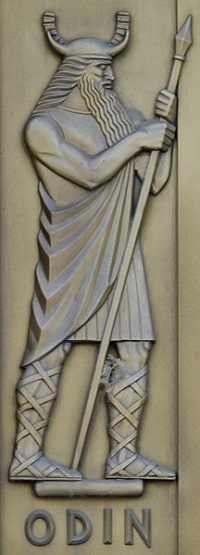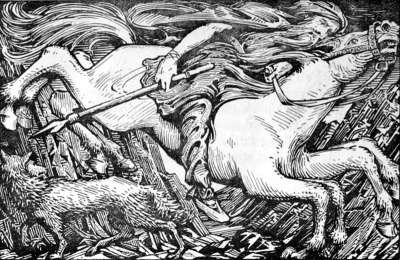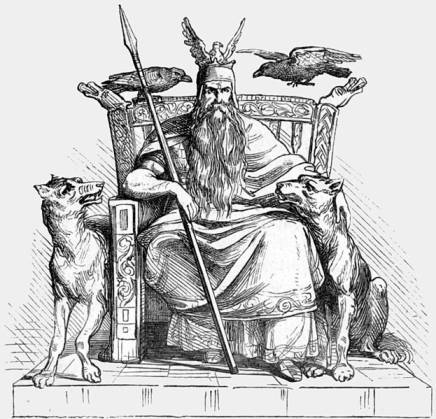Gungnir is not just any weapon; it’s the very spear wielded by Odin, the Allfather of the gods. Its name resonates with power, mystery, and the intricate tapestry of stories that make up the Norse mythological universe.
The spear’s prominence in Norse mythology is undeniable. It’s been at the center of countless tales, from epic battles to divine interventions. But what makes Gungnir so special? Is it its craftsmanship, its magical properties, or the god who brandishes it? Let’s delve deeper and discover the secrets of this legendary spear.
Name and Etymology
“Gungnir” holds a mysterious aura. Originating from the Old Norse word “gung,” it means “swaying” or “rocking.”
It might be that the name paints a vivid picture of a weapon that’s alive, almost sentient, resonating with the energy of the cosmos. This could suggest the spear’s impeccable accuracy, always hitting its target. Additionally, it might convey the powerful tremors it imparts to its wielder and those brave enough to confront it.
Interestingly, the concept of a divine or magical spear isn’t unique to Norse mythology. In other cultures, we find similar weapons imbued with power and significance. For instance, in Celtic myths, there’s the “Gáe Bulg,” a spear of mortal wounding wielded by the hero Cú Chulainn. While the names and stories differ, the underlying theme of a spear with unparalleled power remains consistent, hinting at a shared human fascination with such artifacts.
Gungnir’s Origin and Creation
Gungnir, the legendary spear, holds a captivating story that matches its magnificence. The talented Sons of Ivaldi, dwarves celebrated for their unmatched crafting prowess, forged this marvel of craftsmanship and magic. Notably, they also crafted other wondrous items for the gods.

The spear’s creation wasn’t just about showcasing the dwarves’ skill. Rather, it was intertwined with the politics and rivalries of the gods. When Loki maliciously cut off the hair of Sif, Thor’s wife, he was forced to provide even grander gifts to appease the furious thunder god. This led to the creation of not just Gungnir, but also other magical items that would become central to Norse myths.
From the start, the dwarves crafted Gungnir with unparalleled artistry, showcasing their skill. Moreover, this masterpiece highlighted the intricate relationships between the gods and the Darl Elves.
Description and Characteristics
Envision a weapon shimmering with an otherworldly glow, meticulously crafted to perfection. Its long, sturdy shaft boasts intricate rune carvings. Moreover, each rune narrates a tale of power, destiny, and the vast cosmos.

The spearhead, forged from the finest materials the dwarves could procure, gleams with a sharpness that seems almost unnatural. It’s said that once thrown, Gungnir would pierce through anything, never missing its intended target. This wasn’t just a weapon; it was a work of art, a testament to the unparalleled craftsmanship of its creators.
Magical Abilities
Gungnir was no ordinary spear. Beyond its impeccable craftsmanship, it was imbued with magical properties that made it a force to be reckoned with. One of its most renowned abilities was its unerring accuracy. Legends say that once thrown, Gungnir would always find its mark, no matter the skill of the wielder or the evasiveness of the target.
But the spear’s magic went beyond just its accuracy. Some tales speak of it causing storms or invoking the power of the elements, while others hint at its ability to command respect and authority, making it a symbol of Odin’s dominion over the realms.
Myths Associated with Gungnir

Treasures of the Gods
The tale of Gungnir’s creation is a fascinating one, intertwined with mischief, rivalry, and the unparalleled craftsmanship of the dwarves. This story, found in the “Skáldskaparmál,” recounts how Loki, in one of his mischievous escapades, maliciously cut off the hair of Sif, Thor’s wife. To avoid the wrath of Thor, Loki promises to provide the gods with greater treasures. This leads him to the master dwarf craftsmen Sindri (or Brokkr) and Brokk. In a wager with these dwarves, several magical items are crafted, including Thor’s hammer Mjölnir, as well as Odin’s spear, Gungnir.
To quote from the “Skáldskaparmál”:
“In the hands of Sindri (Brokkr) and Brokk, metal and magic melded, giving birth to artifacts of unparalleled power. Among them, Gungnir stood tall, a spear destined for the Allfather, Odin.”
The Aesir-Vanir War
The Aesir-Vanir war, a monumental conflict between two factions of gods, has its roots in deep-seated rivalries and misunderstandings. However, the official commencement of this war is marked by a symbolic act by Odin. As described in the “Völuspá” from the Poetic Edda, the war is said to have officially begun when Odin, in a display of intent and power, throws Gungnir over the heads of an assembly of Vanir gods.
To quote from the “Völuspá”:
“On the host his spear | did Othin hurl, Then in the world | did war first come; The wall that girdled | the gods was broken, And the field by the warlike | Wanes was trodden.”
Odin’s Quest for Knowledge: Hanging from Yggdrasil
As relayed in the “Hávamál,” specifically in the section known as “Rúnatal,” Odin’s sacrifice is both physical and spiritual. He doesn’t merely hang from the tree; he wounds himself with a spear. The text doesn’t explicitly name the spear. However, given the significance of the act and Odin’s close association with Gungnir, it’s widely believed that it was indeed this legendary spear with which he wounded himself.
To quote from the “Hávamál” stanza 138:
“I ween that I hung | on the windy tree, Hung there for nights full nine; With the spear I was wounded, | and offered I was To Othin, myself to myself, On the tree that none | may ever know What root beneath it runs.”
This act of self-sacrifice, of offering himself to himself, underscores Odin’s unyielding pursuit of wisdom. By enduring pain and hanging in a liminal space between life and death, Odin gains insights into the mysteries of the runes, the ancient symbols that hold immense power and knowledge. Gungnir’s role in this profound event further cements its importance in the pantheon of Norse artifacts and myths.
Ragnarok: The Doom of the Gods
Ragnarok, the prophesied end of the gods, is a tale of cataclysmic battles, betrayals, and the eventual rebirth of the world. As the gods prepare for their final stand against the forces of chaos, Odin, the Allfather, rides forth on his steed Sleipnir. And in his hand, as always, is Gungnir, ready to be wielded against the monstrous wolf, Fenrir. While the outcome is tragic, with Odin meeting his end at the jaws of Fenrir, Gungnir’s presence is a testament to its enduring significance in the myths. As Odin charges into battle, the spear is not just a weapon but a symbol of his authority, legacy, and the inevitable cycle of destruction and rebirth.
Frequently Asked Questions
Gungnir translates to “swaying” or “trembling” in Old Norse, possibly alluding to its unwavering accuracy.
The master dwarf craftsmen known as the Sons of Ivaldi created Gungnir.
Both artifacts have unique properties. While Gungnir boasts unerring accuracy, Mjölnir is known for its immense destructive power.
No, the spear was crafted by the dwarves as part of a wager involving Loki.
Yes, many cultures have tales of divine or magical spears, such as the “Gáe Bulg” in Celtic myths.
Gungnir is known for its impeccable accuracy, always finding its mark. It’s also imbued with various runes granting it unique powers.
Featured Image Credit: Lorenz Frølich, Public domain, via Wikimedia Commons
